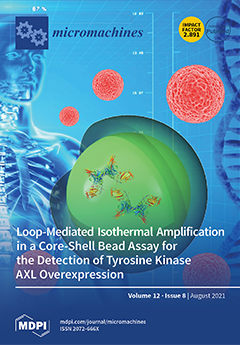A novel and efficient enzymatic glucose sensor was fabricated based on Fe
3O
4 magnetic nanoparticles (Fe
3O
4MNPs)-modified urchin-like ZnO nanoflowers (ZnONFs). ZnONFs were hydrothermally synthesizing on a flexible PET substrate. Fe
3O
4MNPs were deposited on
[...] Read more.
A novel and efficient enzymatic glucose sensor was fabricated based on Fe
3O
4 magnetic nanoparticles (Fe
3O
4MNPs)-modified urchin-like ZnO nanoflowers (ZnONFs). ZnONFs were hydrothermally synthesizing on a flexible PET substrate. Fe
3O
4MNPs were deposited on the surface of the ZnONFs by the drop-coating process. The results showed that the urchin-like ZnONFs provided strong support for enzyme adsorption. For Fe
3O
4MNPs, it significantly promoted the redox electron transfer from the active center of GOx to the ZnO nanoflowers beneath. More importantly, it promoted the hydrolysis of H
2O
2, the intermediate product of glucose catalytic reaction, and thus improved the electron yield. The sensitivity of the Nafion/GOx/Fe
3O
4MNPs/ZnONFs/Au/PET sensor was up to 4.52 μA·mM
−1·cm
−2, which was improved by 7.93 times more than the Nafion/GOx/ZnONFs/Au/PET sensors (0.57 μA·mM
−1·cm
−2). The detection limit and linear range were also improved. Additionally, the as-fabricated glucose sensors show strong anti-interference performance in the test environment containing organic compounds (such as urea, uric acid, and ascorbic acid) and inorganic salt (for instance, NaCl and KCl). The glucose sensor’s service life was evaluated, and it can still maintain about 80% detection performance when it was reused about 20 times. Compared with other existing sensors, the as-fabricated glucose sensor exhibits an ultrahigh sensitivity and wide detection range. In addition, the introduction of Fe
3O
4MNPs optimized the catalytic efficiency from the perspective of the reaction mechanism and provided potential ideas for improving the performance of other enzymatic biosensors.
Full article






